Morpho-functional changes of cardiac telocytes in isolated atrial amyloidosis in patients with atrial fibrillation
- PMID: 33574429
- PMCID: PMC7878494
- DOI: 10.1038/s41598-021-82554-0
Morpho-functional changes of cardiac telocytes in isolated atrial amyloidosis in patients with atrial fibrillation
Abstract
Telocytes are interstitial cells with long, thin processes by which they contact each other and form a network in the interstitium. Myocardial remodeling of adult patients with different forms of atrial fibrillation (AF) occurs with an increase in fibrosis, age-related isolated atrial amyloidosis (IAA), cardiomyocyte hypertrophy and myolysis. This study aimed to determine the ultrastructural and immunohistochemical features of cardiac telocytes in patients with AF and AF + IAA. IAA associated with accumulation of atrial natriuretic factor was detected in 4.3-25% biopsies of left (LAA) and 21.7-41.7% of right (RAA) atrial appendage myocardium. Telocytes were identified at ultrastructural level more often in AF + IAA, than in AF group and correlated with AF duration and mitral valve regurgitation. Telocytes had ultrastructural signs of synthetic, proliferative, and phagocytic activity. Telocytes corresponded to CD117+, vimentin+, CD34+, CD44+, CD68+, CD16+, S100-, CD105- immunophenotype. No significant differences in telocytes morphology and immunophenotype were found in patients with various forms of AF. CD68-positive cells were detected more often in AF + IAA than AF group. We assume that in aged AF + IAA patients remodeling of atrial myocardium provoked transformation of telocytes into "transitional forms" combining the morphological and immunohistochemical features with signs of fibroblast-, histiocyte- and endotheliocyte-like cells.
Conflict of interest statement
The authors declare no competing interests.
Figures

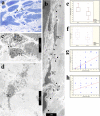

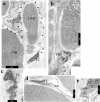
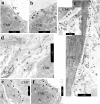
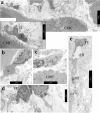
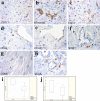
Similar articles
-
Telocytes in human isolated atrial amyloidosis: ultrastructural remodelling.J Cell Mol Med. 2010 Dec;14(12):2739-47. doi: 10.1111/j.1582-4934.2010.01200.x. J Cell Mol Med. 2010. PMID: 21040457 Free PMC article.
-
[Morphological features of the myocardium of the atrial appendages in patients with different forms of atrial fibrillation].Arkh Patol. 2017;79(4):3-12. doi: 10.17116/patol20177943-12. Arkh Patol. 2017. PMID: 28791992 Russian.
-
Atrial amyloidosis: an arrhythmogenic substrate for persistent atrial fibrillation.Circulation. 2002 Oct 15;106(16):2091-7. doi: 10.1161/01.cir.0000034511.06350.df. Circulation. 2002. PMID: 12379579
-
Heart failure with preserved ejection fraction, atrial fibrillation, and the role of senile amyloidosis.Eur Heart J. 2019 Apr 21;40(16):1287-1293. doi: 10.1093/eurheartj/ehz057. Eur Heart J. 2019. PMID: 30753432 Free PMC article. Review.
-
Surgical pathology of atrial appendages removed during the cox-maze procedure: a review of 86 cases (2004 to 2005) with implications for prognosis.Am J Surg Pathol. 2013 Jun;37(6):890-7. doi: 10.1097/PAS.0b013e31827e180b. Am J Surg Pathol. 2013. PMID: 23629441 Review.
Cited by
-
Exosomes enriched by miR-429-3p derived from ITGB1 modified Telocytes alleviates hypoxia-induced pulmonary arterial hypertension through regulating Rac1 expression.Cell Biol Toxicol. 2024 May 20;40(1):32. doi: 10.1007/s10565-024-09879-0. Cell Biol Toxicol. 2024. PMID: 38767703 Free PMC article.
-
Anticoagulation in Atrial Fibrillation Associated With Cardiac Amyloidosis: A Narrative Review.Cureus. 2024 Jun 3;16(6):e61557. doi: 10.7759/cureus.61557. eCollection 2024 Jun. Cureus. 2024. PMID: 38962633 Free PMC article. Review.
-
Cardiac stem cells: Current knowledge and future prospects.World J Stem Cells. 2022 Jan 26;14(1):1-40. doi: 10.4252/wjsc.v14.i1.1. World J Stem Cells. 2022. PMID: 35126826 Free PMC article. Review.
-
Elucidating the preventive and therapeutic effects of cardiac telocytes paracrine microRNAs on ischemic heart disease.Front Cardiovasc Med. 2025 Apr 1;12:1540051. doi: 10.3389/fcvm.2025.1540051. eCollection 2025. Front Cardiovasc Med. 2025. PMID: 40236257 Free PMC article.
-
Telocytes inside of the peripheral nervous system - a 3D endoneurial network and putative role in cell communication.Rom J Morphol Embryol. 2022 Apr-Jun;63(2):335-347. doi: 10.47162/RJME.63.2.05. Rom J Morphol Embryol. 2022. PMID: 36374139 Free PMC article. Review.
References
Publication types
MeSH terms
LinkOut - more resources
Full Text Sources
Other Literature Sources
Medical
Miscellaneous

